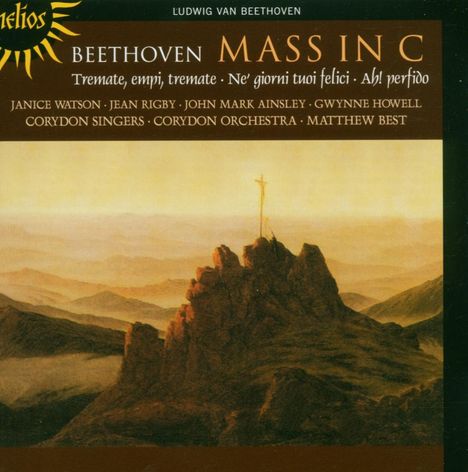Ludwig van Beethoven: Messe C-dur op.86 auf CD
Messe C-dur op.86
Herkömmliche CD, die mit allen CD-Playern und Computerlaufwerken, aber auch mit den meisten SACD- oder Multiplayern abspielbar ist.
Lassen Sie sich über unseren eCourier benachrichtigen, falls das Produkt bestellt werden kann.
+Ah! perfido; Ne' giorni tuoi felici; Tremate, empi, tremate
Ähnliche Artikel
Beethoven komponierte die Messe in C-Dur 1807 im Auftrag von Prinz Nikolaus Esterházy. Obgleich seine Position als Komponist instrumentaler Arbeiten zu dieser Zeit gesichert war, hatte er in der Komposition von Kirchenmusik weniger Erfahrung und niemals zuvor den Text zu einer Messe gesetzt. (Er sollte dieses nur noch einmal vornehmen, über ein Jahrzehnt später, in der Missa solemnis.) Ein anderer stark hemmender Faktor waren die damals schon berühmten Messen Haydns, der zu dieser Zeit noch am Leben war, und mit dessen Werken die Versuche Beethovens ohne Zweifel gemessen werden würden. Somit fand er es schwierig, seinen Auftrag zu erfüllen—so schwierig, dass er sich gezwungen sah, dem Prinzen Esterházy im späten Juli 1807 zu schreiben, um sich für die Verspätung zu entschuldigen und zu versprechen, das vollendete Werk bis spätestens am 20. August zu liefern. Es wurde erstmals am 13. September in Eisenstadt als Teil eine Namenstagfeier für die Frau Esterházys, Prinzessin Maria, aufgeführt. Esterházy jedoch war enttäuscht, und als Folge hiervon unterließ Beethoven die beabsichtigte Widmung für ihn; als die Messe erstmals 1812 von Breitkopf & Härtel veröffentlicht wurde, war sie dem Gönner Beethovens, Prinz Kinsky, gewidmet.
Product-Information:
Beethoven composed the Mass in C in 1807 to a commission from Prince Nikolaus Esterházy. Although by this time his status as a composer of instrumental works was assured, he was less experienced in sacred music and had never before set the words of the Mass. (He was to do so only once more, over a decade later, in the Missa solemnis.) Another powerful inhibiting factor was the well-known corpus of Masses by Haydn, himself still alive, against which Beethoven’s attempt could hardly fail to be measured. Thus he found it difficult to fulfil the commission: so much so that he was forced to write to Prince Esterházy late in July 1807 apologizing for the delay and promising to deliver the completed work by 20 August at the latest. It was first performed at Eisenstadt on 13 September as part of the name-day celebrations for Esterházy’s wife, the Princess Maria. But Esterházy was disappointed with it, and as a result Beethoven suppressed the intended dedication to him; when the Mass was first published, by Breitkopf & Härtel in 1812, the dedication was to Beethoven’s patron Prince Kinsky.
Rezensionen
'Two budget recordings of this underrated mass stand out … My own favourite, the more dramatic 1995 version conducted by Matthew Best. He conjures a prayerful mood for the Kyrie and Andante, and a fierce exultation in the Gloria and Credo. Orchestra and chorus are incisive, and the balance ensures that you hear all Beethoven's woodwind detail, not least his inspired touches of bassoon colouring' (The Daily Telegraph)
'A fascinating CD' (The Recorder)
Disk 1 von 1 (CD)
Messe C-Dur op. 86
-
1 Kyrie
-
2 Gloria
-
3 Credo
-
4 Sanctus
-
5 Benedictus
-
6 Agnus Dei
Ah, perfido op. 65 (Konzertarie für Sopran und Orchester)
-
7 Szene: Ah! perfido, spergiuro
-
8 Arie: Per pietà, non dirmi addio...
-
9 Ne' giorni tuoi felici WoO 93
-
10 Tremate, empi, tremate op. 116 (für Sopran, Tenor, Bass und Orchester)
Mehr von Ludwig van Beet...
-
Ludwig van BeethovenKönig Stephan op.117CDAktueller Preis: EUR 7,99
-
Ludwig van BeethovenDie Geschöpfe des Prometheus op.43CDVorheriger Preis EUR 7,99, reduziert um 0%Aktueller Preis: EUR 2,99
-
Ludwig van BeethovenMödlinger Tänze WoO 17 Nr.1-11CDAktueller Preis: EUR 7,99
-
Carl Heinrich ReineckeSämtliche Klaviertrios2 CDsAktueller Preis: EUR 14,99











